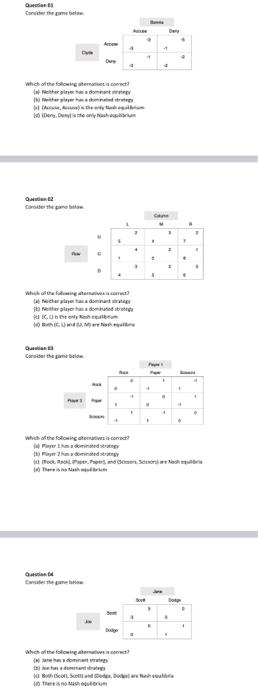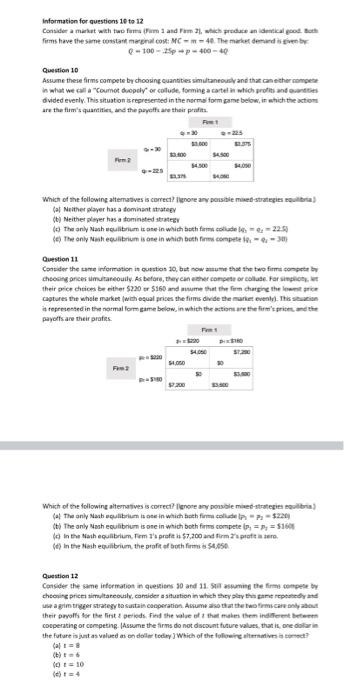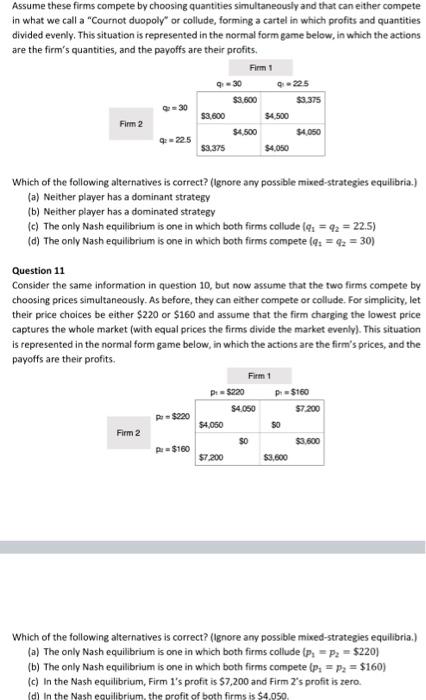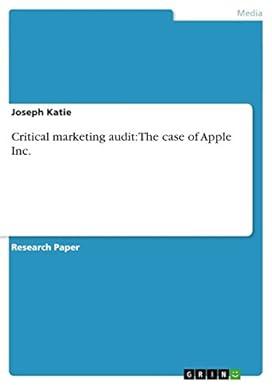Answered step by step
Verified Expert Solution
Question
1 Approved Answer
Heres a better image Whel of the folcoing aterearivet it nowect? Quaten L2 Careatei the pawe betise {w) hach an plaper haia asminart atratept (t)


Heres a better image 
Whel of the folcoing aterearivet it nowect? Quaten L2 Careatei the pawe betise \{w) hach an plaper haia asminart atratept (t) Recher alrpo tan a dse- ratiod sbobtrge (it) ic. d b the oul, Resh epirterint Quatien ta Which of the folceing aternativer is comoct? (v) Payer 1 hin a dorinstrd steatiery (1) Rayw 7 han a dominated strate 6 ? a a poilen tal Conster the dane heise Which of the faliceire ateraitivet it nomert? (1) lare hel f dominal viated (t) ket hat a dreekselt dedefy informatisn for questions 10 to 12 Q=100=25p+p=400=40 Question 10 in what we call a "Coumot duopely or colusle, forming a cattel in wich grofits and awantioti duided everly. This situstion is represersed in the nerms form kame below, if shich the actiont are the firm's quantitiest. and the nuyciff are their pridits. (a) Mrithet payer has a dominant strateey (b) Neither yyerhasatominstedstratesy (c) The anly Mash vecuterium is pee in which bech famn coliute (Wh = de 22.5 ) Question 11 Consider the tatee irfermation it putstion 10, but now anaytie that the two firma pongete by it tepresested in the notmal form game below, in whith the attiont are the firtit fritert, and the paycts are their praties. (a) The anly Mash eculiterium is oee in which bach firma collate the =P2=$220. (t) The only Mash ecuabriure is one in which both fims compete (n1=3=11601) (c) In the Wath equlibrium. Fem 7's prafit is $7,200 and tirm 7 a prot 4 an aere. (c) In the Heih equatbrium. the profit of buth firmis a 40.056. Question 12 cosperating of ccmpeting. Assume the firms do not dscount funure values. that if, one dollar in: {a}1=z (t) t=b () r=10 (c) f=4 Assume these firms compete by choosing quantities simultaneously and that can either compete in what we call a "Cournot duopoly" or collude, forming a cartel in which profits and quantities divided evenly. This situation is represented in the normal form game below, in which the actions are the firm's quantities, and the payoffs are their profits. Which of the following alternatives is correct? (Ignore any possible mixed-strategies equilibria.) (a) Neither player has a dominant strategy (b) Neither player has a dominated strategy (c) The only Nash equilibrium is one in which both firms collude (q1=q2=22.5) (d) The only Nash equilibrium is one in which both firms compete (q1=q2=30) Question 11 Consider the same information in question 10, but now assume that the two firms compete by choosing prices simultaneously. As before, they can either compete or collude. For simplicity, let. their price choices be either $220 or $160 and assume that the firm charging the lowest price captures the whole market (with equal prices the firms divide the market evenly). This situation is represented in the normal form game below, in which the actions are the firm's prices, and the payoffs are their profits. Which of the following alternatives is correct? (Ignore amy possible miked-strategies equilibria.) (a) The only Nash equilibrium is one in which both firms collude (p1=p2=$220) (b) The only Nash equilibrium is one in which both firms compete (p1=p2=$160) (c) In the Nash equilibrium, Firm 1's profit is $7,200 and Firm 2 's profit is zero. (d) In the Nash equilibrium, the profit of both firms is $4,050. Whel of the folcoing aterearivet it nowect? Quaten L2 Careatei the pawe betise \{w) hach an plaper haia asminart atratept (t) Recher alrpo tan a dse- ratiod sbobtrge (it) ic. d b the oul, Resh epirterint Quatien ta Which of the folceing aternativer is comoct? (v) Payer 1 hin a dorinstrd steatiery (1) Rayw 7 han a dominated strate 6 ? a a poilen tal Conster the dane heise Which of the faliceire ateraitivet it nomert? (1) lare hel f dominal viated (t) ket hat a dreekselt dedefy informatisn for questions 10 to 12 Q=100=25p+p=400=40 Question 10 in what we call a "Coumot duopely or colusle, forming a cattel in wich grofits and awantioti duided everly. This situstion is represersed in the nerms form kame below, if shich the actiont are the firm's quantitiest. and the nuyciff are their pridits. (a) Mrithet payer has a dominant strateey (b) Neither yyerhasatominstedstratesy (c) The anly Mash vecuterium is pee in which bech famn coliute (Wh = de 22.5 ) Question 11 Consider the tatee irfermation it putstion 10, but now anaytie that the two firma pongete by it tepresested in the notmal form game below, in whith the attiont are the firtit fritert, and the paycts are their praties. (a) The anly Mash eculiterium is oee in which bach firma collate the =P2=$220. (t) The only Mash ecuabriure is one in which both fims compete (n1=3=11601) (c) In the Wath equlibrium. Fem 7's prafit is $7,200 and tirm 7 a prot 4 an aere. (c) In the Heih equatbrium. the profit of buth firmis a 40.056. Question 12 cosperating of ccmpeting. Assume the firms do not dscount funure values. that if, one dollar in: {a}1=z (t) t=b () r=10 (c) f=4 Assume these firms compete by choosing quantities simultaneously and that can either compete in what we call a "Cournot duopoly" or collude, forming a cartel in which profits and quantities divided evenly. This situation is represented in the normal form game below, in which the actions are the firm's quantities, and the payoffs are their profits. Which of the following alternatives is correct? (Ignore any possible mixed-strategies equilibria.) (a) Neither player has a dominant strategy (b) Neither player has a dominated strategy (c) The only Nash equilibrium is one in which both firms collude (q1=q2=22.5) (d) The only Nash equilibrium is one in which both firms compete (q1=q2=30) Question 11 Consider the same information in question 10, but now assume that the two firms compete by choosing prices simultaneously. As before, they can either compete or collude. For simplicity, let. their price choices be either $220 or $160 and assume that the firm charging the lowest price captures the whole market (with equal prices the firms divide the market evenly). This situation is represented in the normal form game below, in which the actions are the firm's prices, and the payoffs are their profits. Which of the following alternatives is correct? (Ignore amy possible miked-strategies equilibria.) (a) The only Nash equilibrium is one in which both firms collude (p1=p2=$220) (b) The only Nash equilibrium is one in which both firms compete (p1=p2=$160) (c) In the Nash equilibrium, Firm 1's profit is $7,200 and Firm 2 's profit is zero. (d) In the Nash equilibrium, the profit of both firms is $4,050 
Step by Step Solution
There are 3 Steps involved in it
Step: 1

Get Instant Access to Expert-Tailored Solutions
See step-by-step solutions with expert insights and AI powered tools for academic success
Step: 2

Step: 3

Ace Your Homework with AI
Get the answers you need in no time with our AI-driven, step-by-step assistance
Get Started


